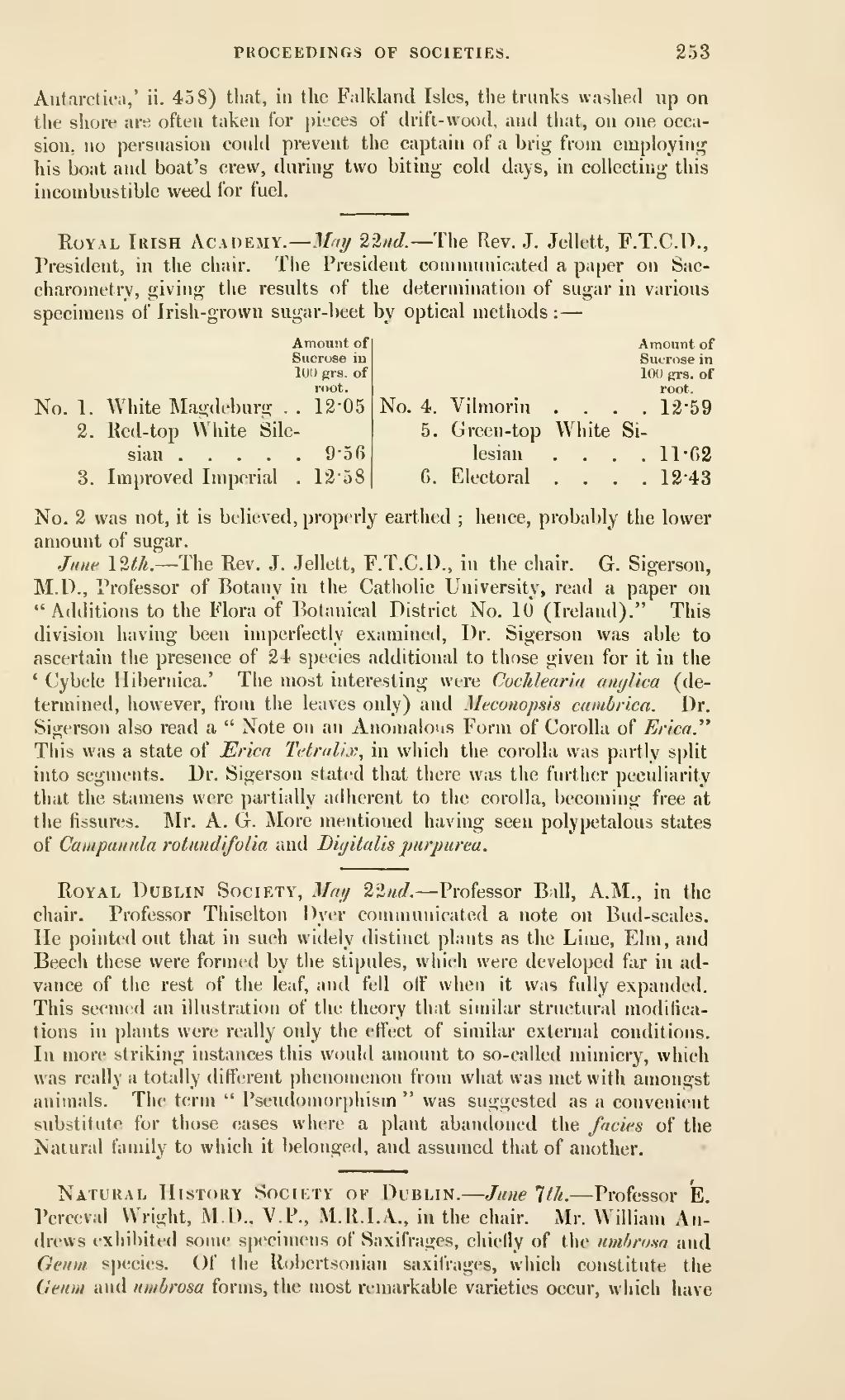PROCEEDINGS OF SOCIETIES. 253
Antarctica,' ii. 458) that, in the Falkland Isles, the trunks washed up on the shore are often taken for jjieces of drift- wood, and that, ou one occa- sion, no persuasion could prevent the captain of a brig from employing his boat and boat's crew, during two biting cold days, in collecting this incombustible weed for fuel.
�� �Amount of
� � �Amount of
� �Sucrose in
� � �Sucrose in
� �lUO grs. of
� � �100 grs. of
� �root.
� � �root.
�L
�White Magdeburg- . . 12-05
�No.
�4.
�Vilmorin .... 12-59
�2.
�Bed- top vVhite Sile-
sian 9-56
� �5.
�Green-top White Si-
lesian . . . .11-62
�3.
�Improved Imperial . 12'58
� �G.
�Electoral .... 12-43
��Royal Irish Academy.— J/r/y 22nd.— The Rev. J. Jellett, F.T.C.D., President, in the chair. The President communicated a paper on Sac- charometry, giving the results of the determination of sugar in various specimens of Irish-grown sugar-beet by optical mctiiods : —
��No.
��No. 2 was not, it is believed, properly earthed ; hence, probably the lower amount of sugar.
J/me 12^/^.— The Rev. J. .lellett, P.T.C.D., in the chair. G. Sigerson, M.D., Professor of Botany in the Catliolic University, read a paper on "Additions to the Flora of Botanical District No. 10 (Ireland)." This division having been imperfectly examined, Dr. Sigerson vvas able to ascertain the presence of 24 species additional to those given for it in the ' Cybele Hibernica.' The most interesting were CocJdearia cuujlica (de- termined, however, from the leaves only) and Mecouopsis caiubrica. Dr. Sigerson also read a " Note on an Anomalous Form of Corolla of Erica." This was a state of Erica TatraUx, in which the corolla was partly split into segments. Dr. Sigerson stated that there was the further peculiarity that the stamens were partially adherent to the corolla, becoming free at the fissures. Mr. A. G. More mentioned having seen polypetalous states of Cainpaiinla rotundifolia and Bigilalis purpurea.
��Royal Dublin Society, May 22nd. — Professor Ball, A.M., in the chair. Professor Thiselton Dyer commnuicated a note on Bud-scales. He pointed out that in such widely distinct plants as the Lime, Elm, and Beech these were formed by the stipules, which were developed far in ad- vance of the rest of the leaf, and fell off when it was fully expanded. This seemed an illustration of the theory that similar structural modifica- tions in plants were really only the (effect of similar external conditions. In more striking instances this would amount to so-called mimicry, which was really a totally different phenomenon from what was met with amongst animals. The term " Pseudomorphism " was suggested as a convenient substitute for those cases where a plant abandoned the fades of the Natural family to which it belonged, and assumed that of another.
��Natural History Society of Dublin. — Jane 1th. — Professor E. Perceval Wright, M.D.. V.P., M.R.I. A., in the chair. Mr. William An- drevvs exhibited some specimens of vSaxifrages, chielly of the umhrom and Genm species. Of the Robertsonian saxifrages, which constitute the Geum and umbrosa forms, the most remarkable varieties occur, which have
�� �
